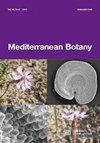坎塔布里亚山脉维管植物名录
IF 0.7
4区 生物学
Q3 PLANT SCIENCES
引用次数: 2
摘要
我们提供了第一份标准化的坎塔布里亚山脉维管植物群清单,坎塔布里亚山是西班牙西北部欧洲西伯利亚和地中海生物地理区域之间的过渡带。研究区域包括15000 km2,划分为10 km x 10 km的UTM网格单元,我们对西班牙植物信息系统(Anthos)和伊比利亚和马卡龙岛植被在线数据库(SISIM)中报告的发生数据进行了修订。我们使用半自动程序将分类学概念标准化为一个单一的名称列表,并在国家和地区文献的支持下通过基于专家的修订进行了进一步更新。在当前版本中,坎塔布里安山脉的清单包含2338个本地物种和亚种,其中56个是研究地区的特有物种。清单的命名法在97%的分类群中遵循欧洲+地中海,包括使用其他标准时的注释,以及状态不确定的分类群。我们还提供了一份492个在研究区域错误报告的非本土分类群的列表,一份当地无融合生殖分类群的名单,一份与《植物名录》相关的系统发育树,80%植物群的艾伦伯格生态指示值的标准化计算,以及关于生命形式、国际自然保护联盟威胁类别和法律保护状况的信息。我们的综述展示了坎塔布里亚山脉如何代表南欧的一个关键植物区系区域和西南欧的相关植物地理中心。清单和所有相关信息都可以在数字存储库中免费获取,以进一步用于基础研究和应用研究本文章由计算机程序翻译,如有差异,请以英文原文为准。
Checklist of the vascular plants of the Cantabrian Mountains
We present the first standardized list of the vascular flora of the Cantabrian Mountains, a transitional zone between the Eurosiberian and Mediterranean biogeographic regions in northwestern Spain. The study area comprises 15000 km2 divided in UTM grid cells of 10 km x 10 km, for which we revised occurrence data reported in the Spanish Plant Information System (Anthos) and the online database of Iberian and Macaronesian Vegetation (SIVIM). We used a semi-automatic procedure to standardize taxonomic concepts into a single list of names, which was further updated by expert-based revision with the support of national and regional literature. In the current version, the checklist of the Cantabrian Mountains contains 2338 native species and subspecies, from which 56 are endemic to the study area. The nomenclature of the checklist follows Euro+Med in 97% of taxa, including annotations when other criteria has been used and for taxa with uncertain status. We also provide a list of 492 non-native taxa that were erroneously reported in the study area, a list of local apomictic taxa, a phylogenetic tree linked to The Plant List, a standardized calculation of Ellenberg Ecological Indicator Values for 80% of the flora, and information about life forms, IUCN threat categories and legal protection status. Our review demonstrates how the Cantabrian mountains represent a key floristic region in southern Europe and a relevant phytogeographical hub in south-western Europe. The checklist and all related information are freely accessible in a digital repository for further uses in basic and applied research
求助全文
通过发布文献求助,成功后即可免费获取论文全文。
去求助
来源期刊

Mediterranean Botany
Agricultural and Biological Sciences-Plant Science
CiteScore
2.40
自引率
10.00%
发文量
30
审稿时长
12 weeks
期刊介绍:
Mediterranean Botany (ISSNe 2603-9109), formerly Lazaroa, is a biannual journal that publishes original research studies in the field of Botany including plant systematics, vegetation ecology, biogeography, evolutionary biology, ecophysiology, community ecology, ethnobotany and conservation biology on Mediterranean biomes but also in interacting areas.
Mediterranean Botany is an OPEN ACCESS Journal, free of charges for any published article.
 求助内容:
求助内容: 应助结果提醒方式:
应助结果提醒方式:


